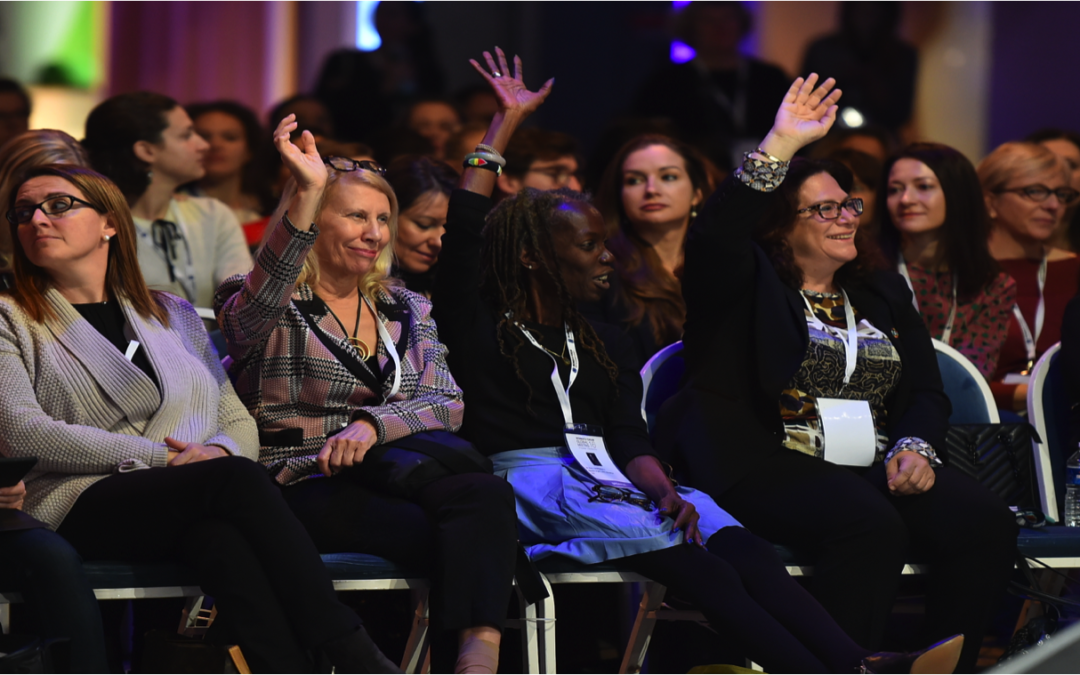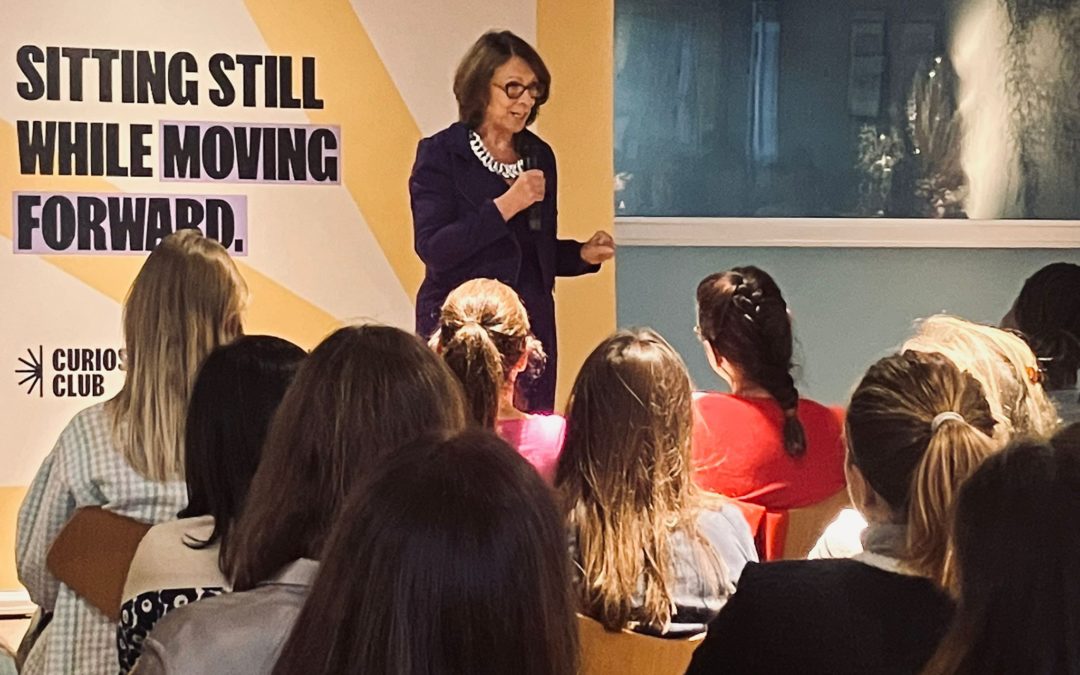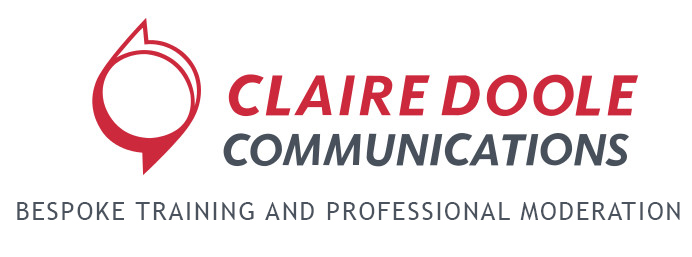
by Claire Doole | Jun 11, 2025 | Blog, Public Speaking
For some presenters, the Q&A is the best part of any speaking engagement. They are more at ease, enjoy the exchange and sharing knowledge.
But for others, the question-and-answer segment can be extremely testing even for the most seasoned presenter. Here are a few challenges:
• Online events: Questions pour in via the chat, leaving the presenter frantically scrolling up and down to find the pertinent questions.
• External events or conferences: When audience members seize the opportunity to talk about their organization or experience, rather than ask a question to the presenter. (As a panel moderator, a comment rather than a question from audiences is an occupational hazard!).
• Town halls: When the presenter/speaker is faced with a challenging staff member, keen to ask that killer question.
• Formal meetings or hearings: The presenter is required to answer many questions in a fixed amount of time, often from members who ask multiple questions on a wide variety of subjects.
Having faced all of the above – as a panel moderator and presentation trainer here are some techniques for staying calm and focused when the questions start flying.
• Anticipate the difficult questions: When preparing your presentation or remarks, think about your audience and the specific challenging questions you could expect from them.
• Set the rules of engagement: Let the audience know that you want questions, not comments. If an audience member goes into a long speech, you can then legitimately ask them what their question is. (As a panel moderator I intervene on behalf of the audience when a questioner goes into comment mode!)
• Listen carefully to the question and seek clarification if you don’t understand it: As the presenter, you have to make sure that not only you but also the audience understands what is being asked.
• Have a process for taking online questions: When I moderate online press briefings or panel discussions, I also group the questions that flood in from journalists thematically. However, I signpost clearly which question is for which speaker and ask them one by one.
I also like to have a google doc where the event producer can copy and paste the questions as they come in on the chat. They can tweak the English and prioritize the question, even suggesting which question goes to which speaker. This makes it easy for me to group by theme, and ensure that each speaker gets at least one question.
Next month I shall share more tips on answering tough questions, whether they come at a town hall, conference or public hearing.
Claire Doole is a former BBC journalist, UN, IFRC and WWF International spokeswoman who has for more than twenty years trained and coached executives in the art of answering tough questions from the media, employees or the public. You can find out more at www.doolecommunications.com

by Claire Doole | Sep 26, 2024 | Blog, Public Speaking
“We are a new women’s networking group in Geneva and would love you to talk for 40 minutes about your career in communications”, says Valentine Honoré, the founder of the Curiosity Club.
My first reaction was, do I really want to talk about myself? The second, was do I have anything to say? And my third, 40 minutes is far too long.
You would think I would jump at the chance of talking to this group of women. But I have spent most of my professional life not talking about myself. I have always been most comfortable when asking questions as a journalist, or conference moderator, speaking on behalf of an organization or training people to speak in public or to the media!
Although the invite was out of my comfort zone, I thought it would be good to put myself in the shoes of the clients I train and coach in public speaking. They often tell me that they are also uncomfortable talking about themselves even though they know that personal stories help people connect.
Below are some tips and techniques on how I went about telling my story.
The audience is King (or in this case Queen!)
The key to impactful public speaking is making it audience centric. I thought about what this audience of mostly career women in their twenties to forties would want to hear that would be useful for them.
I divided my talk into the three main phases of my life – journalism, public relations and current career as a trainer and moderator. For each of these I came up with a life lesson that I felt would help these women advance their careers. For the record, my key messages were:
• Being good at your job is not good enough. You need to network.
• Be true to yourself. If you are not feeling empowered, leave your job!
• Know your own value, particularly when negotiating salaries or fees.
Storytelling builds connection
I illustrated the key messages with personal stories so that they would be memorable. Some of the stories were humorous or at least self-depreciatory, some revolved around unusual twists of fate and others were more poignant such as incidents of gender discrimination and worse. I wanted to be honest about the ups and the downs.
I added some insights on the state of the media, the rise of celebrity news and the spread of disinformation – subject areas that I have some expertise in, and some strong opinions!
Opening with impact
The Curiosity Club had chosen a great venue – le blé noir restaurant at La Comédie de Genève – the city’s premier theatre. I started with a few remarks about the reasons for my theatrical voice and a story about my short-lived career treading the boards.
At the start of a talk or speech, you should connect with the audience, by speaking about where they are at physically, mentally or emotionally. My theatrical voice had opened professional doors for me and I thanked the Club for opening their doors and inviting me to talk about communications in an ever-changing world.
Speaking without notes
You have much more impact if you speak directly to your audience, without any notes. I am always asked what you should do if you forget something. I always reply that the audience doesn’t know what you are going to say so won’t notice.
However, you can maximize your chances of not forgetting a key point if each point builds logically on the next. For example, I talked about covering the death of Princess Diana in Paris and this led me onto the challenges of being a female reporter and producer in an era where men filled most of the foreign correspondent roles in the BBC.
It helps too if you have a clear structure. I chose a chronological one from past to present.
Owning the stage
The stage was small, but I decided I would make every step count. I started and ended in the center. Stage left was my time as a journalist. Stage right my time in public relations and I moved between the two to illustrate a number of challenging transitions from journalism to public relations and back again.
Keeping to time
I had practiced and rehearsed my talk – saying it out loud like an actor as that helps the words stick. I thought it would be around 30 minutes, but in fact it was 37 minutes, as I responded to the reactions of the audience, and threw in a few more questions and thoughts as they came to me. This makes it sound even more natural and unscripted.
Still, 37 minutes is very long. TED talks are now a maximum 15 minutes, down from 18 minutes, no doubt to cater for people’s shortened attention spans. When I coach TEDx speakers, I usually advise 10 to 12 minutes. We all overestimate an audience’s ability to focus on what we are saying.
Amazingly, Curiosity Club members are, as their name suggests, innately curious and I asked them to tell me if they lost interest at any point. No one said they did, but remember we are in diplomatic Geneva!
It was however a lot of work to write the talk and deliver it without notes, even though this is what I do for a living.
Sitting still while moving forward
is the mantra of the Curiosity Club – an organization that works towards gender equality. The club holds meetings all over the world for women who want to exchange ideas, inspire each other and network.
I failed to network sufficiently at the start of my career, and only started when I set up my business. It is not something I now have a great deal of time to do, but networking with members of the Curiosity Club in Geneva was highly enjoyable and didn’t feel like work at all.

by Claire Doole | Apr 28, 2019 | Blog, Public Speaking
Every conversation is a presentation, and no conversation has higher stakes than a job interview. To succeed, you need to convince a potential employer you are the right person for the job.
Over the past year, I have been coaching people in the art of the effective job interview – with a 100% success rate so far. This is probably due to the fact that so many aspects of presenting yourself to a future employer rely on presenting and public speaking skills – my areas of expertise.
Here are some tips essential to effective presenting that can be applied to the job interview.
Put yourself in the shoes of the your audience
Look at every question from the employer’s perspective and do your homework. This means doing a detailed research of the company and what their needs are both today and in the future. With this information, you can explain your assessment of their challenges and opportunities and why you can help them meet them.
For example, when asked why are you interested in the job, you could reply:
“I’ve had twelve years in customer service positions, with four years managing the whole department. Your position clearly demands a strong service component in areas where I have expertise.”
Highlight the benefits to the audience
What is in it for them? This is very important to spell out when presenting and indeed training, but especially so in a job interview. They are hiring you to meet a new challenge or solve a problem. You need to show them you are the ideal solution.
Often the first question in a job interview is along the lines of present yourself/tell us about yourself or what do you do?
You need to mention what you do but also highlight the value it brings to them.
If I were to do this for my business to a prospective client working for an international organisation, I would say:
“I am a former BBC journalist, UN spokeswoman and head of media at WWF International,(features) with more than 15 years as a trainer helping international organisations communicate more effectively (benefits). This means I can advise you on how to better influence policy decisions on X in Y country (added value).
This technique can also be used at a networking event when you have to present yourself and your business. In this instance, you may want to create interest and provide a potential hook by saying something intriguing to encourage them to ask more. It is known as an elevator pitch in that you should be able to deliver it to your dream prospect that you bump into by the time the elevator has gone from the top to ground floor.
Back up your assertions with proof points
In an interview you will often be asked about why you are the right person for the job. Here you need to identify what makes you stand out from the competition.
The easiest way to do this is to make a point and then give an example.
“I have an excellent track record in helping manufacturing companies make a profit. My team looks to see where they can cut costs or increase their margins. With a typical client, we can boost their profits by 7% in the first year. With one car manufacturer we worked with a couple of years ago we recommended a lot of changes and their first-year profit went up by 15%.”
Planned spontaneity
These types of answers need to be prepared before but delivered as if this is the first time you have said them. Strange as it may seem, this means you need to practice delivering them in front of the mirror or even better film yourself on your smart phone. You also have to make sure that your tone and body language give a positive impression.
In future blogs, I shall share how to use the right non-verbal communication, apply storytelling techniques and handle some of the trickier questions that you may be asked in a job interview.



